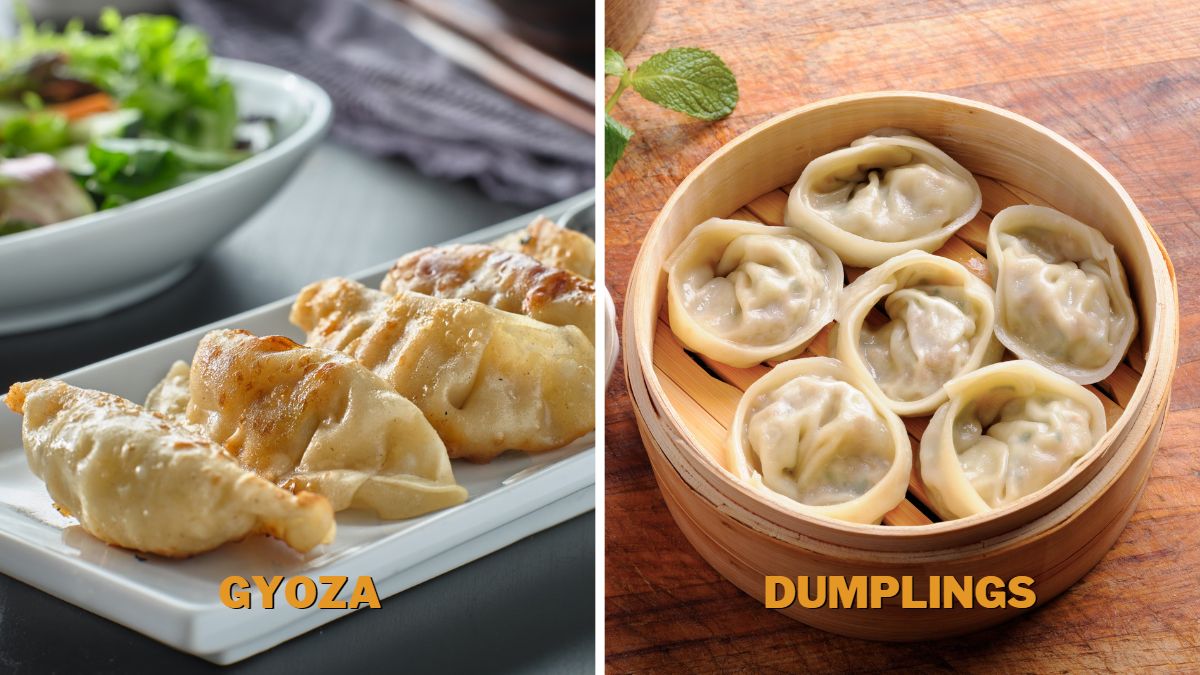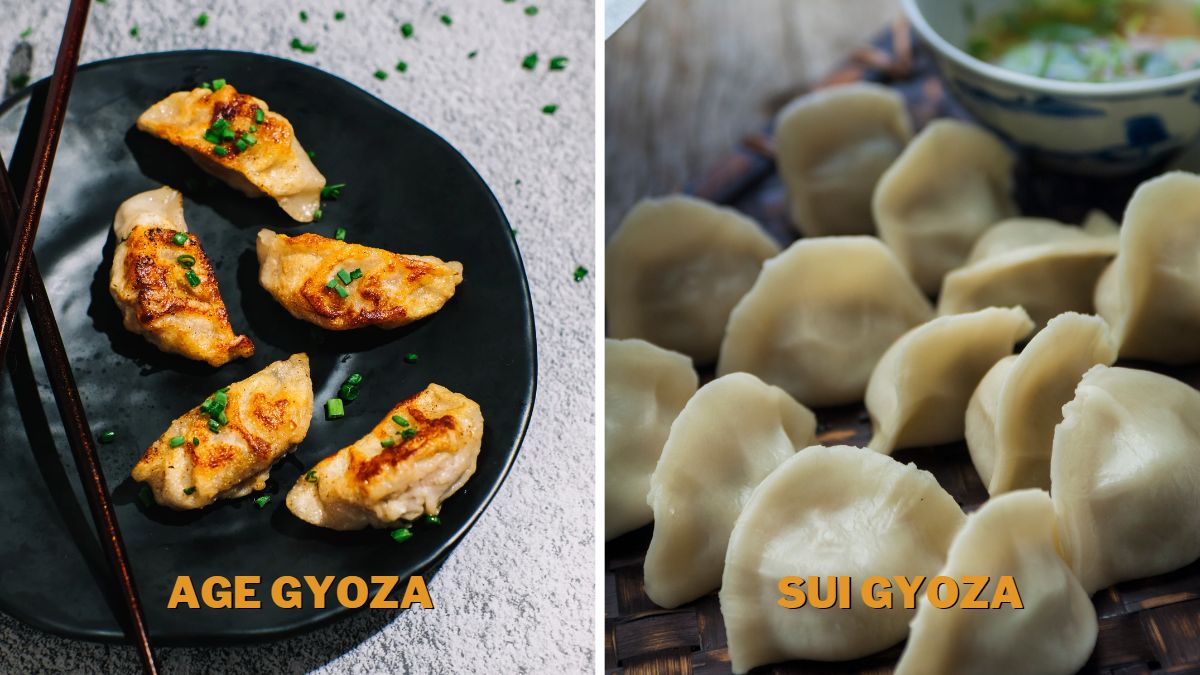Gyoza vs. Dumplings: Differences & Which Is Better?

Gyoza and dumplings are both Asian pastry delicacies and very similar to each other. However, they differ in certain aspects, which makes them two separate dishes. So what are the differences between gyoza and dumplings?
While dumplings are an old Chinese delicacy, gyozas were introduced in Japanese cuisine around WW2. Dumplings and gyozas are both hot pastry pockets filled with various fillings. While dumplings can be filled with all kinds of fillings, gyozas are usually filled with pork, cabbage, and garlic.
Although very similar, there are noticeable differences between gyozas and dumplings. I will explain the differences between gyoza and dumplings in the following paragraphs.
Gyoza vs. Dumplings: Differences
A dumpling is a crescent or pouch-shaped pastry filled with choice filling. In a nutshell, gyoza is a Japanese dumpling filled traditionally with minced cabbage and pork seasoned with a lot of garlic.
Even though gyozas derive from dumplings, they have acquired traits unique to them over the years, turning them into separate dishes.
In the paragraphs below, I will explain the differences between gyozas and dumplings in terms of origin, preparation, nutrition, taste, and nutrition.
Cuisine and Origin
Dumplings originated in China during the reign of the Eastern Han Dynasty, and it is believed that they were invented by the medical practitioner Zhang Zhongjing. According to the legend, China was experiencing one of the harshest winters in its history, and many people fell ill due to the cold.
To help people recuperate and keep them fed, Doctor Zhang Zhongjing filled hot dough pockets with herbs people ate to feel better. With time dumplings underwent many changes and became a synonym for China.
Gyozas have a significantly shorter history. They came into Japanese cuisine somewhere around WW2, during the Japanese invasion of Manchuria. The Japanese soldiers learned about dumplings and took the recipe home to Japan.
Since then, Gyozas have been adjusted to Japanese cuisine, and today they exist as a separate dish. Dumplings are called jiaozi in Chinese, and the Japanese pronunciation of gyoza is very close to the Chinese name.
Dough
Both gyoza and dumpling wrappers are made the same way, using the same ingredients. They require only salt, water, and wheat flour.
The mixture is then kneaded to turn into dough. The dough is separated into balls which are then rolled to get the wrapper. The gyoza and dumpling wrappers are thin but robust enough to hold the filling. However, gyoza wrappers are thinner than dumpling wrappers.
In addition to the plain dumpling dough, there are other types of dumpling dough in Chinese cuisine, using fermented cornmeal, banana peels, etc.

Ingredients and Preparation
Dumplings can be filled with anything. Since when they were invented, they have been filled with herbs, and everything you have goes. They were made to feed people and use everyday ingredients. Mostly they are filled with minced meat, but there are also vegetarian and vegan variations, according to the consumer’s preference.
Gyozas, too can be filled with anything, but they are traditionally filled with minced pork and cabbage and are seasoned with a lot of garlic. However, gyoza variations are filled with vegetables, shrimp, and salmon.
Dumplings are traditionally pan-fried and steamed. However, there are boiled dumplings, pan-fried, and then baked.
Gyozas are traditionally pan-fried but can also be steamed, boiled, and deep-fried.
Taste
Except for the mandatory wrapper, dumplings are very variable in filling, and the filling is the part that gives the flavor. So, depending on what you fill them with, they will taste like that.
Gyozas are also very versatile but mostly filled with cabbage, pork, and garlic. Therefore they taste like a combination of these three.
Gyozas and dumplings are generally filled with minced meat and vegetables, so they taste meaty combined with cooked vegetables. Both gyozas and dumplings often contain garlic, which is the dominating flavor. The vegetarian and vegan versions also taste like garlic mixed with vegetables.
Nutrition
Gyozas and dumplings have very similar nutritional values. They have carbs from the dough, protein from the meat, and fiber and vitamins from the vegetables. Still, none of the ingredients are fresh, so they aren’t particularly nutritious.
However, dumplings and gyozas are not harmful unless you have a food allergy. They aren’t fatty, and you would have to eat an insane amount of them to load on the carb. You can eat them daily and in moderation.
Varieties
There are four different kinds of gyoza, deep fried or Age gyoza, boiled or Sui gyoza, steamed or Mushi gyoza, and pan-fried or Yaki gyoza. They can all be filled with various fillings since the filling doesn’t depend on the manner of cooking.

Dumplings are a universe in themselves. There are two general types of dumplings in terms of shape, crescent, and pouch-shaped. However, these two categories have countless subtypes, depending on the filling.
Dumplings aren’t categorized according to the cooking method like Gyozas are, as the cooking method depends on the filling.
Serving and Side Dishes
Both gyozas and dumplings can be served alone as the main dish. If they are served with another side, it is typically rice or fried vegetables with mushrooms. They can also be served with sauces and soups.
Why Do People Call Dumplings Potstickers?
According to the story, a dumpling got stuck to the bottom of the pot, so it got the name “potsticker”- something that sticks to a pot.
